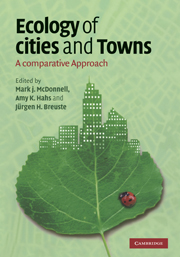Book contents
- Frontmatter
- Contents
- List of contributors
- Preface
- 1 Introduction: Scope of the book and need for developing a comparative approach to the ecological study of cities and towns
- Part I Opportunities and challenges of conducting comparative studies
- 2 Comparative urban ecology: challenges and possibilities
- 3 Frameworks for urban ecosystem studies: gradients, patch dynamics and the human ecosystem in the New York metropolitan area and Baltimore, USA
- 4 Comparative effects of urbanisation in marine and terrestrial habitats
- 5 Comparative ecology of cities and towns: past, present and future
- 6 Comparative urban ecological research in developing countries
- 7 Using models to compare the ecology of cities
- Part II Ecological studies of cities and towns
- Part III Integrating science with management and planning
- Part IV Comments and synthesis
- References
- Index
- Plate section
2 - Comparative urban ecology: challenges and possibilities
Published online by Cambridge University Press: 04 March 2010
- Frontmatter
- Contents
- List of contributors
- Preface
- 1 Introduction: Scope of the book and need for developing a comparative approach to the ecological study of cities and towns
- Part I Opportunities and challenges of conducting comparative studies
- 2 Comparative urban ecology: challenges and possibilities
- 3 Frameworks for urban ecosystem studies: gradients, patch dynamics and the human ecosystem in the New York metropolitan area and Baltimore, USA
- 4 Comparative effects of urbanisation in marine and terrestrial habitats
- 5 Comparative ecology of cities and towns: past, present and future
- 6 Comparative urban ecological research in developing countries
- 7 Using models to compare the ecology of cities
- Part II Ecological studies of cities and towns
- Part III Integrating science with management and planning
- Part IV Comments and synthesis
- References
- Index
- Plate section
Summary
Introduction
Our research has been inspired by the views of Dennis and Ruggiero (1996) who emphasised that even simple inventories, if done with quality and consistency and repeated over large geographical areas, can provide valuable understanding about ecology and the impacts of humans across the world. Approximately 75% of the human population in industrialised countries lived in cities in 2003 and it is projected that half of the world's population will be urban by 2007 (United Nations,2004). In order to ensure that urban areas are planned for the well-being of both city dwellers and urban biodiversity, knowledge of the responses of the urban ecosystem – including ecological and human components – to the influence of urbanisation is pivotal (McDonnell and Pickett, 1990; Niemelä, 1999a).
Urbanisation creates patchworks of modified land types that exhibit similar patterns throughout the world. Nonetheless, little is known about whether these changes affect biodiversity in similar ways across the globe, or depend more on local conditions (Samways, 1992). Thus, there is a need for comparative, international research to assess the effects of these activities on native biodiversity, and, where possible, to minimise adverse effects (Dennis and Ruggiero, 1996; Andersen, 1999). Such research could potentially distinguish globally recurring patterns and convergence from more local phenomena. The new knowledge could enhance the development of urban ecology as a scientific discipline and foster international collaboration among researchers and managers in finding ways to mitigate the adverse effects of human-caused landscape change.
- Type
- Chapter
- Information
- Ecology of Cities and TownsA Comparative Approach, pp. 9 - 24Publisher: Cambridge University PressPrint publication year: 2009
- 15
- Cited by

